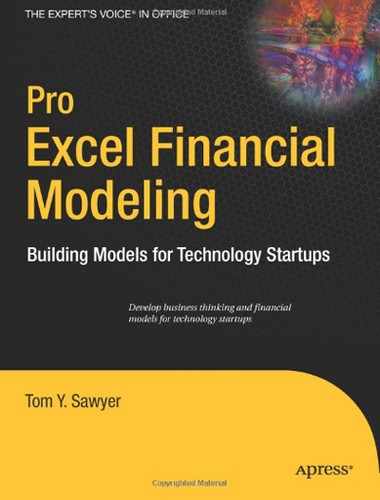CHAPTER 8
Cost of Product Development Model
Technology startup companies have two primary cost drivers:
- Product development
- Sales and marketing
The cost of product development is the cost the company incurs to design, build, and deliver its product to the market. A financial model, in and of itself, cannot define or articulate strategies for designing and developing products. It can, however, model the application of resources planned for the implementation of these strategies. The Cost of Product Development (DEV) model quantifies and forecasts the resources needed to the implement a company's product development strategy.
In this chapter, you will learn how to plan, create, and use the DEV model. In addition, you will learn
- About business objectives and product development strategies
- What resources are to be considered and planned for in the DEV model
- How to develop a model to forecast and quantify the total cost of product development needed to support the product development life cycle
Business Thinking About Product Development
Product development is the lifeblood and core process of a technology company. All other processes take their cues from and are dependent on, to a greater or lesser extent, product development. Failure in product development generally spells failure for the company. The objective of product development is to implement a development process that assures the product output exhibits the qualities the customer wants to see. A company that can uncover what a customer wants and design, build, and distribute a product to meet those needs at an acceptable cost will be successful.
This comprehensive process, which I will call product life cycle management (PLM), includes all aspects of product development from inception to retirement, from customer requirements and conceptual design to detail and production design, and from manufacturing to sales support and maintenance services. In today's world, product development is increasingly evolving in the direction of complex electromechanical systems that include a significant component of embedded software.
The product development implementation strategy is the key to the kingdom of technology company success.
Note At best, a book on financial modeling can only present a conceptual framework for modeling product development and the costs associated with it. In practice, the product development strategy is highly complex. The financial model can only reflect and represent the product development strategy by presenting the time phasing and quantification of resources required to implement the strategy. The primary product development financial model output is the company's cost of product development, hence the title to this chapter.
In practice, product development strategy is highly complex and requires extensive and detailed attention. One example of this complexity, which is beyond the scope of this book, is the need for formal project planning. It is critical that early-stage companies utilize a formal project planning methodology and tools like Microsoft Project to develop detailed resource-loaded project plans. Project plans should be integrated with the financial model and linked so that changes in the project plan flow directly into the model. It should be noted that most early-stage companies are resource constrained and under tremendous pressure to get a product out the door. Though it may seem counterintuitive, this is precisely the time when it is most important to implement formal planning and project control methodologies. You don't have to invest in fancy collaboration systems to create a working environment that values and practices these disciplines.
To begin business thinking about product development, we must first view it at a strategic level and within a framework of business objectives and technology company critical success factors. We should also view business objectives from the traditional perspective of time, cost, and quality. In other words, the product must be developed quickly and efficiently, at a reasonable cost, and be of high quality, exceeding customer demands.
The next section will discuss top-level business objectives, strategies, and tactics for achieving them.
Product Development Objectives, Strategies, and Tactics
Each of the following subjects points to a critical product development capability and best practice that should be considered by a high-tech startup:
- Product concept and design
- Planning
- Time to market
- Product development and production
- Team
- Product life cycle
- Quality
- Development capacity
- Customers
- Suppliers
- Intellectual property
Creating Product Concept and Design
Product design must address the following to be smart, efficient, and flexible:
Objective: Develop smart product designs, and quickly develop market intelligence that guides the company through key decisions in product specification and product positioning. The objective is that dollars spent and product development effort expended result in early business success.
Strategy: Product design must clearly support identified opportunities, features, and functions of the product, and the product's value proposition must be validated with potential customers.
Tactics: A company must take early action to interview, understand, and gather requirements from representative customers in their target markets.
Note It usually takes the same amount of time and talent to design a product that meets the needs of a few customers as one that will meet the needs of many. Given the limited resources of most startups, it behooves a company to leverage its resources to meet the greatest demand. This means that targeting the right market segment and meeting the requirements of that segment are the most critical decisions that the company makes.
Planning
Here are important considerations to guarantee effective product planning:
Objective: Implement a formal and proactive planning process to manage all aspects of PLM.
Strategy: Formalized planning will be a key factor in management of the product development process. Planning will be ingrained and trained into the organization and will become a critical business skill of the company.
Tactics: A company will engage in formal and proactive planning of all aspects of PLM. Plans will be developed at multiple levels and will be integrated with sales and marketing strategies.
Optimizing the Time to Market
Time to market is critical. Consider the following, and shrink your time to market:
Objective: Bring products to market fast and efficiently.
Strategy: The time to market can be critical to a product's success, and the window of opportunity may be narrow. The first to market may enjoy a significant competitive advantage. Every day that can be shaved off time to market increases sales potential. The use of prototypes can uncover key information about the way your customer views your value proposition resulting in faster, more focused product innovation.
Tactics: Production prototypes must be placed in the hands of customers at the earliest possible date. Formal informational feedback loop practices will be used to garner information from the field.
Adopting Agile Product Development and Production
Optimization of product development from a cost and production standpoint is critical. Adopt the following approach for optimal results:
Objective: Optimize product development and production costs, developing the product efficiently and at as low a cost as possible.
Strategy: Product development cost is a critical metric for technology companies. The primary strategy to accomplish this goal is to do it right the first time, thus reducing iterations.
Tactics: A company must adopt practices and technologies that optimize product development, which might include the following:
- Adopting concurrency as the primary environment for developing products
- Creating designs that reduce complexity and therefore reduce the need for iterations in product design
- Implementing quick response feedback loops for engineering changes
- Adopting agile and responsive change management practices
- Creating a collaborative design work environment and providing access to integrated product data and collaboration tools
- Utilizing state-of-the-art enabling technologies like CAD, CAM, CAE, and PDM
- Driving down component costs by closely managing the design-to-manufacturing process
Forming the Team
The right skills and the right time are necessary for the right team. Consider the following strategies to achieve the correct mix of talent at the right time:
Objective: Build a product development team with the right skills and utilize the right methods to achieve product development success.
Strategy: Early on, visionary and pathfinder developers are needed. They must have the ability to work quickly and innovatively in unstructured and rapidly changing environments. As the company matures, the composition of the team should evolve toward a homesteader staffing profile.
Tactics: Utilize small cross-functional teams and incentivize team members to work collaboratively. Provide them with tools and infrastructure to assist in collaboration across barriers of time, distance, and even cultural differences. Hire the right product development talent at the right times during the evolving stages of product development.
Note See Chapter 4 for a more detailed explanation of visionary, pathfinder, and homesteader staff types.
Managing the Product Life Cycle
The product life cycle must be profitable. Pay attention to the following approaches to managing the full life cycle:
Objective: Design and build for a longer, more profitable product life with a goal of maximizing value throughout its life cycle.
Strategy: It is generally accepted that 70 to 80 percent of the life cycle costs of a product are determined during product development. Create designs with the full product life cycle costs in mind, including the ability to support, modify, and repair products and to take advantage of cheaper materials and components.
Tactics: Work closely with suppliers and manufacturers to design optimized life cycle cost into the product. Closely integrate product design with manufacturing design to optimize handoff to manufacturing.
Building in Quality
Quality must be understood as a fundamental assumption. Keep these ideas in mind as you manage quality throughout the entire product life cycle:
Objective: Develop products that exhibit outstanding quality and that exceed customer expectations while keeping costs in check.
Strategy: Implement rigorous quality control standard methodologies to ensure the highest quality possible for the product. Adopt a rigorous quality orientation within the company, setting quality as a top priority.
Tactics: Implement quality methodologies like Six Sigma. Place high emphasis on testing and customer feedback loops to ensure customer satisfaction with the quality of the products and services.
Note Six Sigma refers to a set of practices first created by Motorola that attempts to systematically remove imperfections in manufacturing processes while improving quality and efficiency. Six Sigma is one of many methodologies that are utilized by companies to improve the quality of their products and services.
Sustaining Development Capacity
To achieve proof of scale, you must prove your company's development capacity. Consider these approaches that will result in scalable development capacity as you grow:
Objective: Create sustainable and scalable development capacity. Scalable capabilities can absorb large increases in volumes with small increases in marginal costs and no loss of quality.
Strategy: Build sustainable and scalable PLM capabilities into the company.
Tactics: Train and invest in all aspects of people, process, and technology necessary to scale to higher levels of output quickly and efficiently. Implement formal and scalable methodologies for planning and software and product development.
Taking Care of Your Customers
Taking care of your customers during their life cycle engagement with you is critical to success. Approach customer satisfaction using the following ideas:
Objective: Design and build customer service and satisfaction into products.
Strategy: Product design should include considerations for customer satisfaction and support.
Tactics: Products should be designed for quick updates and repair. Complementary customer support systems like customer relationship management (CRM) should be tightly integrated into PLM.
Know Your Suppliers
Suppliers can be your best friend or worst enemy. Develop supplier relationships using the following objectives and strategies:
Objective: Develop and optimize supply chain business relationships, and mitigate impact and risk associated with powerful suppliers.
Strategy: Aggressively work with suppliers to develop win-win business relationships. Powerful suppliers like to see growth potential. Make sure they understand your strategies for growth and success.
Tactics: Implement product and manufacturing design and materials sourcing strategies with suppliers that optimize the ability to produce the product at a low cost. Product design should take suppliers and supply chains into consideration to provide maximum flexibility in sourcing parts and materials to reduce cost and risk.
Capture Intellectual Property
Finally, intellectual property (IP) can be one of your most critical assets. Develop and leverage it using the following processes and ideas:
Objective: Capture IP as a formal part of the development process.
Strategy: Build comprehensive IP capture into the product design process.
Tactics: Develop methods to formally integrate technology capture into the design process. For example, within 3-D CAD design, implement a formal capture of the designer's decision criteria in selecting various design alternatives or materials. Implement policies, procedures, training, and technologies that optimize the capture of company IP during the product development life cycle.
Note You really have not finished designing a product until you get it through manufacturing engineering. In other words, plan and own the entire life cycle. Product development is not something you can throw over the wall even if outsourcing is needed.
Developing the Green Devil Control Systems Product Development Strategy
Green Devil Control Systems is an early-stage technology startup that develops energy monitoring and control systems for residential markets. The Company builds and sells the Green Devil Energy Control System (ECS). The Company president has extensive experience and contacts in the home building industry. His partner is a graduate level electrical engineer, and she has extensive experience in developing smart control systems.
Product
ECS is a patent-pending programmable hardware and software device that monitors and controls electricity usage on a circuit-by-circuit basis within a facility. ECS is installed on the facility side of the electrical breaker box.
ECS allows for the mapping of all electric circuits extending into and utilized by the facility and is particularly targeted for the smart homes market. ECS provides switching and control capabilities (like a programmable thermostat) for all individual electrical circuits within a facility. Electrical usage, at the appliance level, can be programmed, controlled, and monitored.
In addition, ECS is a network addressable device. It is designed to work seamlessly with wireless or wired LANs and to support Internet access.
ECS comes with two software options: Local Services (LS) or Extended Services (ES). The LS and ES web browser user interfaces are highly intuitive, attractive, and easy to use.
The LS software is the default option installed with each ECS system and provides for a local web browser user interface to enable local setup and programming. LS provide one month of electricity usage diagnostics.
ES provide Internet-based, secure, remote setup, programming control, and diagnostics. The ES software also provides a suite of analysis tools and system set up tools for optimizing electricity usage. In addition, ES provide demographic comparison data and unlimited usage data and statistics.
ECS hardware is composed of the following integrated components (see Figure 8-1):
- Monitoring (measuring) module: Monitors the usage of electricity
- Switching module: Allows virtual switching of circuits within the home for electricity usage management
- Control module: Controls the unit and contains the embedded software control systems
- Communications module: Provides network connectivity

Figure 8-1. ECS conceptual design showing key modules: monitoring, switching, control, and communications
Scheduling Product Development
Time to market is critical for the Company, which will move quickly to build and test production prototypes and move into manufacturing status. The Company product development strategy (see Figures 8-2 and 8-3) includes the following major milestones and value events:
- Prototype development: Low-level prototype development and testing will be completed by March of YR 1.
- Production prototype development: Ten production prototypes will be built and completed by May of YR 1. Five production prototypes will be used for field testing and five for compliance (lab) and safety testing.
- Field, compliance, and safety testing: There will be two iterations of field and compliance testing, which will include final modifications to the production prototype. Testing will be completed by September of YR 1.
- Manufacturing design: Manufacturing design will begin in May of YR 1 and be completed in November of YR 1.
- Manufacturing: Manufacturing will be outsourced and will begin in November of Year 1.
- Product release: The ECS product (with both software options) will be available in December of YR 1.
- Software: LS software and ES software will be developed in an integrated plan with product development.

Figure 8-2. Company product hardware development master schedule
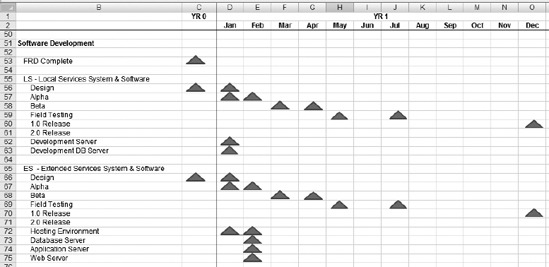
Figure 8-3. Company product software development master schedule
Targeting Operational Dates for Product Availability and Inventory
The Company projects commercial release and product availability in December of YR 1. The manufacturer will ship components to the Company, where they will be inventoried, assembled, and tested prior to shipment to the customer. The Company plans to order and keep in stock (in inventory) a three-month supply of ECS units.
Strategizing Product Development
The Company will follow a formal product development methodology. Product development requires the integrated development of both hardware and software. The following sections offer an overview of the Company's product development strategy.
Generating the Concept
The principals of the Company are subject matter experts in the target market and the technical configuration of the product offering. They will take early action to interview, understand, and gather requirements from representative customers in this market. Specifically, they will work closely with major electrical contractors in their target markets to introduce and test ECS.
Designing the Product
The principals of the Company, being subject matter experts in electrical control system design, will implement industry product development best practices into the design of the product. Specifically, they will tightly integrate production and manufacturing designs to ensure a smooth handoff to the manufacturing outsourcer.
Implementing Rapid Prototyping and Iterative Development Practices
The Company will implement rapid prototyping methodologies for both software and hardware. It will develop a prototype of ECS and quickly get it into the field for testing and to compliance laboratories for compliance and certification. Specifically, the Company will place production prototypes in the hands of potential customers as soon as possible and it will
- Utilize quick-response form, feature, and functionality feedback loops for product engineering changes.
- Adopt agile and responsive change-management practices to ensure that improvement suggestions from the field are rolled into product designs quickly and efficiently, thus reducing time to market.
Developing the Prototype
Prototype development will be implemented under a concurrency methodology using cross-functional work teams. The Company will build a prototype, followed by two more production prototypes that will be field and compliance tested in two test cycles. The Company will also implement the following initiatives in support of the effort:
- Implement formal project plans for software and hardware development.
- Adopt concurrency as the primary environment for developing products.
- Create designs that reduce complexity and the need for iterations in product design.
- Create a collaborative design work environment, providing ready access to integrated product data and collaboration tools.
- Utilize state-of-the-art enabling technologies like CAD.
Manufacturing and Ramping Up
The Company will begin manufacturing design, in close relationship with outsourced manufacturer candidates, concurrently with the beginning of the build of the second production prototype. Final selection of the manufacturer will be based on the demonstrated capability of manufacturer to convert production prototype designs into manufacturing designs and tooling. The Company will implement product and manufacturing design and materials sourcing strategies that optimize the ability to produce the product at low cost and with high quality. Product design will take suppliers into consideration and provide maximum flexibility in sourcing parts and materials to reduce cost and risk.
Implementing Product Testing and Quality Assurance
The Company will implement rigorous quality and product testing programs throughout the life cycle of product development. The Company will present its production prototypes to national laboratories for compliance and safety testing and will secure all certifications necessary for product introduction into national markets.
Creating the Staffing Plan and Organizational Structure
The Company will hire staff and organize itself to optimize the implementation of the aforementioned strategies. The Company will also hire resources to manage its information technology (IT) requirements, and the technical operations department will have total responsibility for these functions. The Company will apply small, cross-functional teams to the product development tasks and offer incentives to team members for working collaboratively, as well as providing the tools and infrastructure to assist in collaboration.
The Company will initially hire developers that fit the visionary and pathfinder staff profile, as described in Chapter 4. As the Company and the product baseline mature, the staff will evolve toward the homesteader profile required to manage mature product and technology baselines.
The Company will incrementally staff the technical operations department as required to support product development and information technology functions. The following is an overview of the organizational structure (see Figure 8-4) and the staff positions that are planned:
Chief technical officer: The CTO is responsible for all aspects of the IT department and reports directly to the president.
Information technology staff: These functional staff positions are responsible for Company information technology including support of business and CRM systems.
Systems integration staff: This functional area staff is responsible for integration of hardware and software product development functions and for hosted services.
Software development staff: This functional area staff is responsible for all aspects of software development in support of product development.
Hardware development staff: This functional area staff is responsible for all aspects of hardware development, manufacturing, and product fulfillment.
Test engineering staff: This functional area staff is responsible for full life cycle testing of product components.
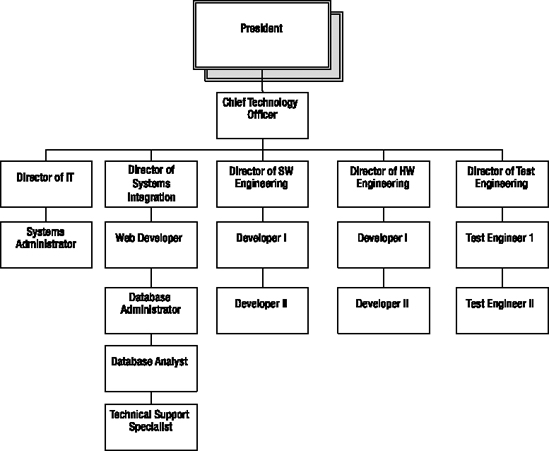
Figure 8-4. The technical operations staff, as outlined in this organizational chart, is responsible for all aspects of Company product development and technology support services.
Considering Other Product Development Strategies
Other product development strategies sometimes fall out of consideration because they are not in the critical path of the standard product development process. Nevertheless, these strategies are very important and add significant value to both the Company and the product and services:
IP capture: The Company will build comprehensive IP capture into the product design process. It will engage legal counsel for patent applications and implement policies, procedures, training, and technologies that optimize the capture of company IP during the product development life cycle.
Customer satisfaction: Product design will include consideration for customer satisfaction and support. Products will be designed for quick updates and repair and with complimentary support systems like CRM.
Product life cycle cost: Company product design heavily considers product life cycle costs and the ability and cost required to support, modify, and repair the product.
Scalable product development capacity: The Company specifically intends to build a sustainable and scalable product development capability. This will be accomplished through training and investment in all aspects of people, process, and technology necessary to scale to higher levels of output quickly and efficiently.
Planning the DEV Model
The purpose of the DEV model is to forecast and quantify resources required to implement the Company product development strategy. The Company should take the following steps prior to designing a DEV model:
- Review all Company business case planning assumptions regarding the product development strategy. Build a time-phased project plan that sets forth the major milestones related to product development, including all events that require expenditures.
- Review and consider staffing requirements and salary ranges needed to implement the strategy. See Chapter 4 to make sure the model accommodates all planning staff requirements for technical operations. Pay particular attention to the timing of technical resource hires to make sure they support the product development schedule.
- Plan the operating expense resources needed to support the strategy (see DEV_CWS in Figure 8-10). DEV_CWS should accommodate planning for product development operating and capital expenses.
- Plan for the development of a Bonus and Commission model to forecast and model bonus and commission compensation (see Chapter 7 for COSM-BONUS_CWS). Bonuses are a major variable expense of product development activities and should be modeled separately from normal expense and capital budgets.
- Plan for the development of a Trip Cost model to forecast technical and manufacturing support related travel (see Chapter 6 for COSM-TRIPPLAN_CWS and COSM-TRIPCALC_CWS). Technical- and manufacturing-related travel is a major variable expense and should be modeled separately from normal expense budgets.
Exploring the Building Blocks of the DEV Model
When the planning is complete, build and test the model. The following section provides an overview of the DEV model and the top-level functionality of model components. See Figure 8-5 for an illustration of the model.
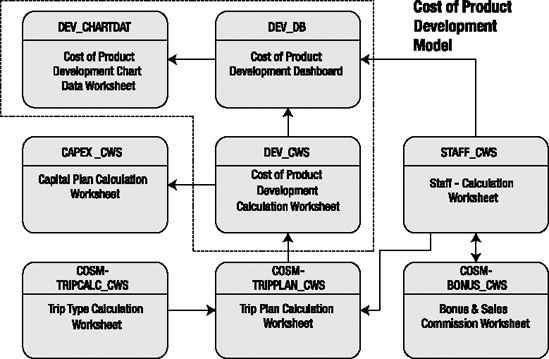
Figure 8-5. Top-level design and process flow of the Cost of Product Development (DEV) model. The core model is within the dotted lines, and arrows represent the major data and process flows.
Using the Staff Calculation Worksheet
The Staff Calculation Worksheet is discussed in detail in Chapter 4. This worksheet plays an important part in the development of the cost of product development. Technical operations support, including staffing salary, bonuses, and commissions, is planned and calculated using this worksheet. In addition, the worksheet also forecasts requirements for phones, computers, and work space needed for the technical operations department staff. To utilize STAFF_CWS as input to the DEV model, follow these steps:
- Go to the Variable Inputs section of STAFF_CWS (see Figure 8-6), and modify the target salaries in the Technical Operations section of the worksheet. Indicate with a "Y" or "N" if a phone (P), computer (C), or work space (WS) is needed for each position. Note that each of the Company's positions requires a phone, computer, and work space, the assumption being that the entire staff will work within formal offices of the Company. Working from home, in this example, is not anticipated.
- In the Technical Operations Variable Inputs section of STAFF_CWS, modify headcount based on the staffing needs of the strategy.
- Go to the SALARY-BENEFIT $ CALC section of the worksheet (cell A160), and if necessary, modify the adjustment to salary for each position. This modification may be done universally, by year, by modifying the adjustment to salary field in STAFF_SP. The combination of the target annual salary and the salary modification field yields the forecasted salary for the position.
You have now planned headcount, salaries, and phone, computer, and work space requirements for the technical operations functions of the Company. The STAFF model computes salaries, taxes, benefits, and related expenses automatically.
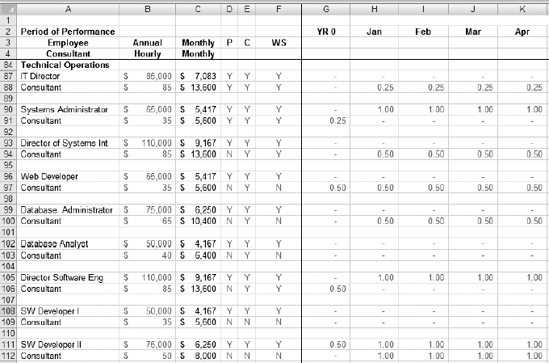
Figure 8-6. The Staff Calculation Worksheet, STAFF_CWS, showing the Variable Inputs section of the Technical Operations planning area.
Using the Bonus and Sales Commission Worksheet
The Bonus and Sales Commission Worksheet, COSM-BONUS_CWS, is a model for forecasting and planning bonuses and sales commissions (see Figure 8-7). This worksheet plays an important part in developing the cost of product development. Bonuses are a primary incentive for key technology management positions. COSM-BONUS_CWS is one example of developing a model for this type of expenditure, but there are many ways to implement a model of this type. The primary functionality of COSM-BONUS_CWS is to develop commissions and bonuses at a top level and to allocate commissions and bonuses back into the detailed compensation calculations of the Staffing model (STAFF) for the purposes of total salaries, wages, and benefits.
Note For a more detailed discussion of building this type of model, refer to Exercise 8-1 at the end of this chapter.

Figure 8-7. COSM-BONUS_CWS, the Bonus and Sales Commission Worksheet, calculates bonuses and commissions for executives, key technology management, and sales and marketing staff.
Using the Trip Type Calculation Worksheet
The Trip Type Calculation Worksheet, COSM-TRIPCALC_CWS, is a model for forecasting and planning business trips for the Company (see Figure 8-8). Travel related to technology, manufacturing support, and consulting is a major variable expense and should be modeled separately, since it is dependent on headcount and product development operating schedules and assumptions. An example of this type of travel would be trips made by hardware developers to visit the manufacturer for technical interchange meetings.
This worksheet is a straightforward model for computing the costs of various types of trips taken during the course of business for the Company. Different trip types are based on variations in airfare, lodging, per diem rates, and rental car expenses. Each trip type has a different assumption for the number of trip days and trip nights. This simple model is utilized by the Trip Plan Calculation Worksheet, COSM-TRIPPLAN_CWS, to compute the total cost of trips.
Note For a more detailed discussion of building this type of model, refer to Exercise 8-2.
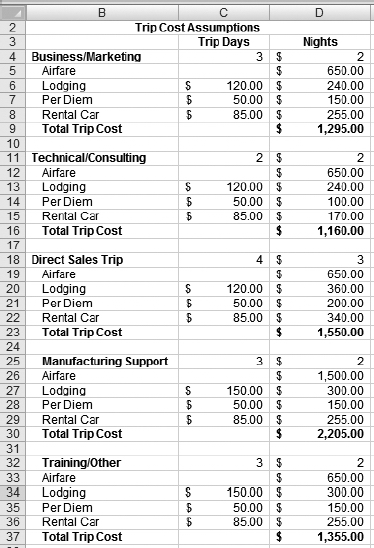
Figure 8-8. COSM-TRIPCALC_CWS is the calculation worksheet for trip cost by type of trip
Using the Trip Plan Calculation Worksheet
The Trip Plan Calculation Worksheet, COSM-TRIPPLAN_CWS, is a model for forecasting and planning business trips for the Company and for computing the total cost of trips (see Figure 8-9). Travel costs related to technology and manufacturing support are a major variable expense and are specifically modeled, and then the costs are included with the other related expense budgets.

Figure 8-9. COSM-TRIPPLAN_CWS, the Trip Plan Calculation Worksheet, forecasts technical operations' technical, consulting, and manufacturing support trips, as well as trips for other Company departments.
Using the Cost of Product Development Calculation Worksheet
The Cost of Product Development Calculation Worksheet, DEV_CWS, is used to develop the operating budget and capital expenditure budget for technical operations (see Figure 8-10). This simple worksheet accepts monthly inputs for expenditures and summarizes expenses for the following categories or groupings of cost; these categories correspond with the organizational structure of Company technical operations:
Information Technology: Operating expenses related to Company IT functions including business systems
Systems Integration: Operating expenses related to systems integration of hardware and software product development functions and for hosted services
Software Development: Operating expenses related to all aspects of software development in support of overall product development
Hardware Development: Operating expenses related to all aspects of hardware development, manufacturing, and product fulfillment
Test Engineering: Operating expenses related to full life cycle testing of product components
Total Tech Ops Trips: The total cost of all technical operations department trips
Capital Requirements: The total technical operations capital expenditure requirements
The last section of the worksheet links to COSM-TRIPPLAN_CWS and picks up the total cost of trips forecasted for product development from the Trip Cost model. There is also a section for the input of capital expenditure forecasts, and these inputs are linked into the Capital Plan, CAPEX_CWS, where they appear as Technical Operations inputs in the total capital plan.

Figure 8-10. DEV_CWS, the Cost of Product Development Calculation Worksheet, develops and summarizes operating expenses and capital expenditures for technical operations.
See Exercise 8-3 in the end of this chapter for a more detailed look at the development of DEV_CWS.
Using the Capital Plan Calculation Worksheet
The Capital Plan Calculation Worksheet, CAPEX_CWS, is discussed in more detail in Chapter 9 and is shown in Figure 8-11. Technical operations capital expenditures are input into DEV_CWS. This data is linked into CAPEX_CWS, where it becomes part of the total capital expenditure plan.
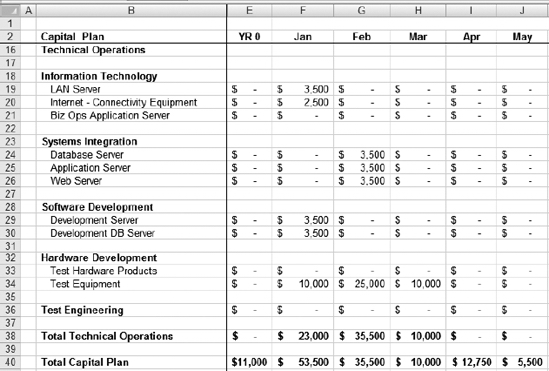
Figure 8-11. CAPEX_CWS, showing the technical operations capital plan
Using the Cost of Product Development Dashboard
The Cost of Product Development Dashboard, DEV_DB, provides an important management summary, or view, of the total cost of product development (see Figure 8-12). In one view, revenue, headcount, compensation, and the total cost of sales and marketing are summarized. This data is created by linking to the worksheets within COSM that we have previously discussed in Chapter 7. The following component data sources make up COSM_DB:
Sales and revenue: Source is REV_DB
Headcount: Source is STAFF_CWS
Compensation: Source is STAFF_CWS
Operating Expense and Capital: Source is DEV_CWS
The summary data from DEV_DB is presented as an overview of the resources that are planned for the technical operations department and for product development in total.
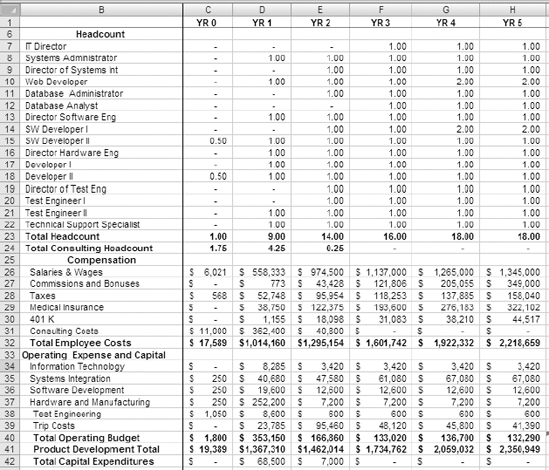
Figure 8-12. DEV_DB, the Cost of Product Development Dashboard, summarizes DEV data and provides a single view of key metrics related to the cost of product development.
Using the Cost of Product Development Chart Data Worksheet
The Cost of Product Development Chart Data Worksheet, DEV_CHARTDAT, summarizes and preformats data used for management charts related to the DEV model (see Figure 8-13).

Figure 8-13. DEV_CHARTDAT, the Cost of Product Development Chart Data Worksheet
EXERCISE 8-1. USING MICROSOFT EXCEL TO DEVELOP A BONUS AND COMMISSION PLAN MODEL
The Company must forecast the total cost of product development. Bonuses are a primary motivator of senior technology management. It is important that a comprehensive compensation plan be developed to attract the type of technical talent the Company needs to be successful.
- Problem: Bonuses are a significant variable cost component of the total cost of product development. Bonuses must be forecast at a level of detail that satisfies the need for a centralized compensation plan and, at the same time, provides data input to other components of the model.
- Solution: Develop a Bonus and Commission model, and utilize the model to forecast bonuses for technical management staff.
Note Refer to Exercise 7-1 for details of model functionality. Utilize the exercises in Chapter 7 as a guide for computing bonuses for senior technical staff.
EXERCISE 8-2. USING MICROSOFT EXCEL TO MODEL TRIP EXPENSES
The Company must forecast total cost of product development. Technical- and manufacturing-related travel costs are a major variable cost of product development.
- Problem: Trip costs are related to product development milestones and to headcount. The costs of airfare, lodging, and per diem expenses are variable based on the type of trip taken. These costs and the number of trips should be modeled separately from operating expense budgets.
- Solution: Develop a Trip Cost model to forecast the cost of trips for the Company.
COSM-TRIPCALC_CWS and COSM-TRIPPLAN_CWS, the trip calculation and planning worksheets, are utilized together to model the cost of trips for the Company. The ideas behind this type of model are simple:
- Company operations will require different types of trips taken by different functional areas in the normal course of business. Trips vary in cost based on trip duration and assumptions on destination and other cost variables, like time of year.
- The Trip Cost model forecasts costs for trip types then forecasts the number of trips by each functional area. The two pieces of data (trip costs and number of trips) are combined to generate the total cost of trips, which is then allocated back into the operating expense budget of each functional area.
Note Refer to Exercise 7-2 for details of model functionality. Utilize the exercises in Chapter 7 as a guide for computing trip costs for technical operations.
EXERCISE 8-3. USING MICROSOFT EXCEL TO DEVELOP THE COST OF PRODUCT DEVELOPMENT CALCULATION WORKSHEET
The Company must forecast the total cost of product development.
- Problem: Nonpersonnel-related technical and manufacturing expenses and capital expenditures related to product development must be forecast.
- Solution: Develop a Cost of Product Development Calculation Worksheet.
DEV_CWS, the Cost of Product Development Calculation Worksheet, is used to develop the operating and capital budget for technical operations. This straightforward worksheet is structured to organize costs based on the organizational structure that has been determined in this chapter. All data is manually input into the model, month by month, with the exception of trip costs, which are computed in COSM-TRIPPLAN_CWS and linked within DEV_CWS. See Figure 8-14 for a data view of DEV_CWS and Figure 8-15 for a formula view of the same spreadsheet.
DEV_CWS provides sections to input operating expenses for the major functions that operate within the technical operations department. The structure of DEV_CWS showing these functional breakouts follows:
- Information technology department operating expenses
- Systems integration department operating expenses
- Software development operating expenses
- Hardware and manufacturing operating expenses
- Test engineering operating expenses
- Total technical operations trip costs
- Total technical operations operating expenses
- Capital requirements

Figure 8-14. The data view of DEV_CWS, the Cost of Product Development Calculation Worksheet
In each departmental section, applicable expenses for the department are manually input and then summarized (see Figure 8-15, rows 15 and 30). Total technical operations expenses are summarized at the bottom of the spreadsheet.
The Total Tech Ops Trips row is linked back to COSM-TRIPPLAN_CWS. See Figure 8-16, which is a formula view of the link for Total Tech Ops Trips. In Figure 8-16, also note the formula view of data input for capital requirements.

Figure 8-15. The formula view of DEV_CWS, the Cost of Product Development Calculation Worksheet

Figure 8-16. The formula view of DEV_CWS, the Cost of Product Development Calculation Worksheet, showing link to COSM-TRIPPLAN_CWS for trip costs
Capital plan inputs (also shown in Figure 8-16) are the source for the capital plan in CAPEX_CWS. See Figure 8-17 for a formula view of CAPEX_CWS, which links back to DEV_CWS to obtain capital expenditure entries for technical operations.

Figure 8-17. The formula view of CAPEX_CWS, showing formula links back to DEV_CWS to get capital inputs from technical operations
Summary
In this chapter, I introduced and explained the Cost of Product Development (DEV) model. The DEV model forecasts the total cost of product development of a company. It is the quantitative representation of the planning for product development.
The cost of product development is the cost the company incurs to design, build, and deliver its product to the market. Product development is the lifeblood and core process of a technology company and all other company processes are dependent, to a greater or lesser extent, on product development. Failure in product development generally spells failure for the company. The objective of product development is to implement a development process that assures that the product delivers the functionality and qualities the customer expects. A company that can uncover what a customer wants, design a product to meet those needs, and build and distribute it at an acceptable cost will be successful.
The product development implementation strategy is the key to the kingdom of technology company success. Business thinking about product development must begin at a strategic level and within a framework of business objectives and technology company critical success factors. We should also view business objectives from the traditional perspectives of time, cost, and quality. In other words, the product must be developed quickly, efficiently, and at a reasonable cost and be of high quality that exceeds customer demands.
In this chapter, we have considered the following critical product development objectives and strategies:
Product concept and design: Designing what the customer wants
Planning: Planning as a key management discipline
Time to market: Being fast to market as a critical success factor
Product development and production: Considering product development life cycle methods and tools
Team: Building the right team at the right time
Product life cycle: Designing for optimized product life cycle cost
Quality: Considering product quality as a way of life
Development capacity: Building scalable product development capacity
Customers: Creating products that keep customers happy
Intellectual property: Capturing IP as you build the product
Here are the key questions to ask yourself regarding company product development and its cost: How will your company get to market fast with a profitable product that meets customer expectations? How much will it cost to accomplish this?
